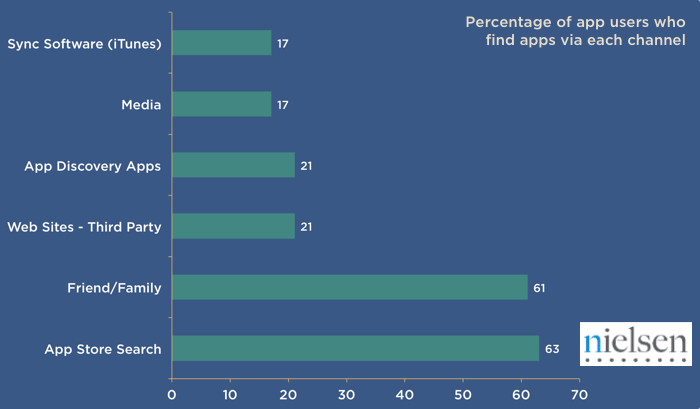Fundamental differences between SEO and ASO
Why not confuse SEO and ASO, in the usual academic manner told Eric Seufert, formerly engaged in marketing at Wooga and Rovio, and now a partner of the agency Heracles. And we translated it.

The original version of the material can be found on Mobile Dev Memo, a website dedicated to the mobile industry, run by Eric himself, who is also the author of the book Freemium Economics.
The term ASO (app store optimization – search optimization in the app store), as a rule, describes the efforts necessary to increase the downloads of the application. They achieve this by making changes on the application page. Historically, the mentioned efforts were mostly directed at search parameters, and therefore they acquired similarities with search engine optimization (SEO), representing the evaluation of keywords and the strategic use of these words in various text elements located on the application page (name, description and even the name of the download file).
However, with the advent of Google Play Analytics, and to a lesser extent (to a much lesser extent than expected when the product was first announced), with the release of iTunes Analytics, along with products such as Storemaven and Splitmetrics, developers were able to truly optimize the application pages to increase conversion. The tests that developers have gained access to – such as A/B testing of icons and screenshots – are able to significantly increase the percentage of people who download the application after visiting its page (of course, not the tests themselves, but the ability to optimize listings with their help). This is what real optimization is, and from the point of view of marketing, such optimization is fundamentally different from simple keyword analysis, which many people take for ASO.

In fact, ASO allows the developer to expand the marketing funnel. ASO gives the developer the opportunity to improve the performance of marketing assets at the stage when a potential user decides whether to download the application or not. Which is extremely important, because 1) in the very act of searching in the store there is a pronounced interest on the part of the user (he clicked on the application advertisement or took care of the application search, and so on), and 2) this optimization enhances the effect of the flow of users from any possible sources. The second point requires clarification: as soon as the conversion of the application page increases, the purchase of users through any traffic channels becomes cheaper (and even organic traffic sources become more efficient).
The value of search optimization in the store becomes obvious when you consider this: it increases the effectiveness of paid campaigns, and the increase in efficiency occurs simultaneously with the growth of the campaign budget. If ASO (or a series of tests designed to improve the ratio of the number of page views to the number of downloads) increases conversion by 10%, it means that a paid campaign will provide the application with 10% more users, regardless of the budget, whether it is $ 100 thousand or $ 1 million.
In the case of keyword analysis (or SEO) everything is different. If keyword analysis (and corresponding changes in the application description, keywords, download file name, and so on) increases the number of installations by, say, 500 per week, then this result will remain unchanged: does the developer spend 100 thousand or 1 million on paid traffic, the growth that was achieved by analyzing keywords, will remain at around 500 downloads per week.
There is another problem that makes us doubt that keyword analysis is something more than just an action that a developer performs once before launching a project. There is too little evidence that an arbitrary keyword search can create at least some serious traffic flow to the application page. Many reasons at the macro level, along with some features of the platforms, lead to the fact that the search, as long as it comes to increasing the visibility of the application, is more or less unimportant. In addition, there is too much difference between form factors and user behavior of online, text-oriented contextual search (from which SEO for app stores borrowed most of the tricks) and mobile app search. Due to this difference, search does not play a big role in increasing the visibility of new applications.
This does not mean, however, that smartphone users neglect the search; according to a study conducted by Nielsen, 63% of all downloads are due to the search in stores. But it is necessary to distinguish a user who is looking for an application already known to him from someone who is looking for keywords and is ready to download the first thing that appears in the search results. In the first case, the search is needed in order to find a specific application, and, of course, such a search is not uncommon (how else would people find applications in the store?); in the second case, the search serves to find new applications, and therefore its expediency is in doubt.

But ultimately, the value of both SEO and ASO is determined by how they stimulate installations. SEO for app stores uses the existing volume of keyword search, and therefore is limited by this volume; no matter how much you analyze keywords, the number of search queries for the phrases “puzzle”, “ad blocker” or “iPhone flashlight” will remain the same. But ASO – those tests that can be carried out to increase conversion – will increase installations in proportion to how much is spent on marketing, as a result of which both the “throat” of the marketing funnel will increase (that is, the visibility of the application will increase) and its “tail” (conversion).
You can’t do this with SEO: the developer can’t influence how many people use keyword search without trying to find a specific application. It is undoubtedly worth investing time in SEO, but it is better to consider this method of optimization as part of a general marketing strategy: SEO depends on the number of search queries that the developer cannot influence, and therefore cannot increase the visibility of the application with its help, and therefore this method of optimization does not fit into the scheme of a full-fledged marketing strategy. And if we take into account the ever-growing number of tools with which a developer can perform ASO, the difference between SEO and ASO naturally becomes even more obvious.
A source: Mobile Dev Memo